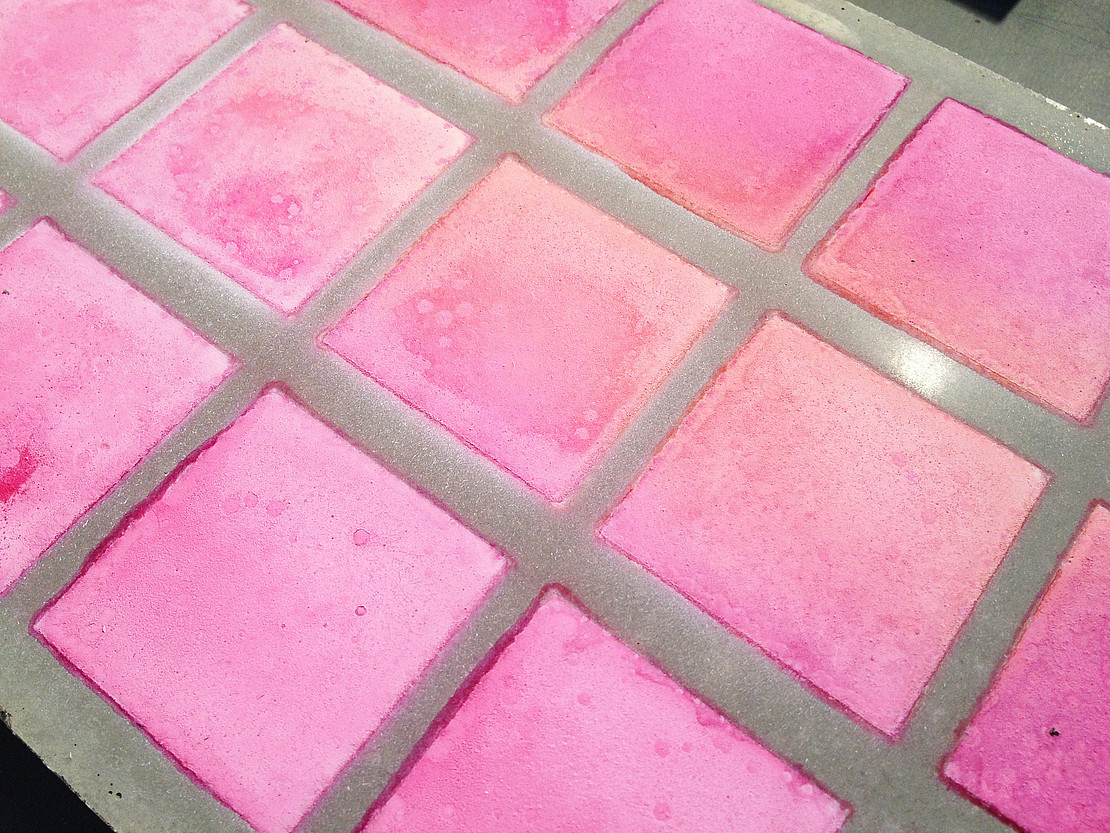This page contains automatically translated content.
Power-producing concrete facades at Expo Dubai
 Image: BAU KUNST ERFINDEN/Klussmann/Klooster
Image: BAU KUNST ERFINDEN/Klussmann/KloosterThe research project "DysCrete/DssCrete" demonstrates the method developed by a transdisciplinary team in several stages since 2016 to make the building material concrete conductive and an electricity-producing solar cell by applying a layer of photoreactive substances. In contrast to solar panels installed on building roofs, this solution, integrated into the architecture, allows great freedom in structural design and thus quality architecture.
In order to be able to apply and renew the necessary coating on facades, a facade robot was also developed, the Plotbot/Crawler. Both developments can be seen as prototypes both at the World Exhibition in Dubai and in the Bau Kunst Erfinden studio in Kassel. Bau Kunst Erfinden is a transdisciplinary research group based in the Department of Visual Arts at the Department of Architecture, Urban Planning, Landscape Planning at the University of Kassel. Since 2009 it has been working on the development of novel material systems in the field of tension between old crafts and new technologies in art, architecture, product design, experimental physics and chemistry. In the projects, artistic strategies, basic sciences and application-oriented engineering approaches overlap. The group thinks across scales from laboratory scale to architectural application.
Electricity from concrete
A look at the energy balance, especially in urban centers, was the initial spark on the way to the invention of "DysCrete" or "DssCrete" (Dye-Sensitized Solar Concrete). Global energy consumption is currently expected to double or even triple by 2050. At the same time, it is estimated that fossil fuel resources will be used up in less than 100 years. How could concrete, the quintessential building material of the last 100 years but, unlike glass-based translucent solar panels, opaque, be used to generate energy? A concrete block doused in fruit juice in the research team's studio that begins to produce electricity was the start of the project. Building on this, the team developed a special conductive concrete coated with layers of titanium dioxide and various other substances. The result is a so-called dye solar cell, with the concrete itself taking on the function of an electrode. The conversion of solar energy into electricity follows the principle of "technical photosynthesis".
Since "DysCrete/DssCrete" has the ability to also use diffuse light, no special orientation to the sun is necessary, so that all sides of the house can be used both indoors and outdoors. In this way, the area share for solar energy generation in urban areas can be significantly increased. A sample calculation, related to the building K10 on the campus of the University of Kassel, shows that 60% of the facades (north, east, south, west - a total of 4747 sqm) could be photovoltaically activated. In addition to the use of the roof (1937 sqm), this would almost double the potential for electricity generation on this building. Advantages over conventional solar systems also include better availability of all raw materials and relatively inexpensive production. The material system has no toxic emissions, is regenerable and largely recyclable.
Dye-sensitized solar concrete is ideally suited for the production of precast concrete elements for building construction, for new types of robust building facades, and for wall and floor systems, and can be integrated into the architectural planning process at an early stage without design restrictions. At the same time, building facades can be retrofitted for energy generation.
The facade robot
In order to be able to apply the complex electricity-producing coating to existing facades without costly scaffolding of the buildings and to renew it at regular intervals, the Bau Kunst Erfinden team led by Prof. Heike Klussmann has developed a novel, web-based and sensor-guided motion automaton, the Plotbot/Crawler, a facade robot. It can be used to control surfaces of building elements of any geometry directly or according to a previously digitally created processing system. It uses spraying and printing techniques in a novel way. The plotbot/crawler can also be modified to perform other tasks on building surfaces, such as maintenance and cleaning, detecting and sealing cracks and flaws, or arborizing vertical facade greening.
The projects were funded by the research initiative Zukunft Bau, Federal Institute for Research on Building, Urban Affairs and Spatial Development, in the Federal Ministry of the Interior, for Building and Home Affairs, and the DFG - German Research Foundation. This research funding provides important impulses for the construction industry. The Zukunft Bau funding program is a building block of the High-Tech Strategy for Germany, which aims to expand the bridge between research and future markets.
More information:
www.baukunsterfinden.org
https://www.uni-kassel.de/fb06/institute/architektur/fachgebiete/bildende-kunst-iforschungsplattform- bau-kunst-erfnden/forschung
and
www.expo2020germany.de